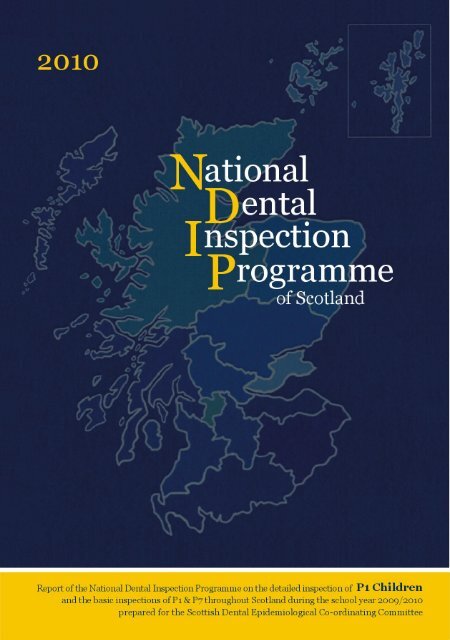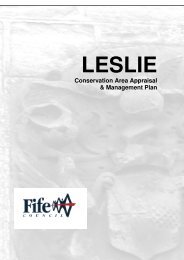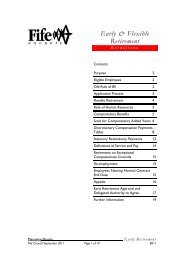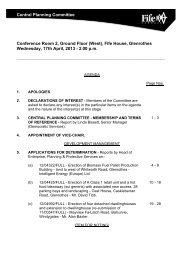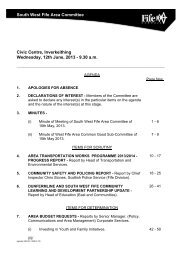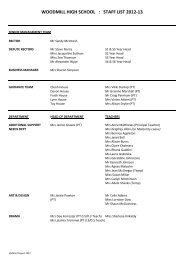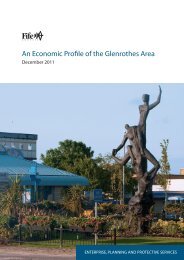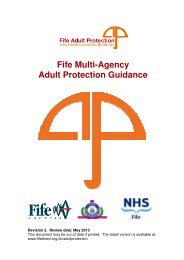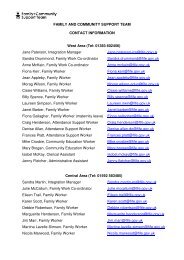National Dental Inspection Programme of Scotland - Scottish Dental
National Dental Inspection Programme of Scotland - Scottish Dental
National Dental Inspection Programme of Scotland - Scottish Dental
Create successful ePaper yourself
Turn your PDF publications into a flip-book with our unique Google optimized e-Paper software.
<strong>National</strong> <strong>Dental</strong> <strong>Inspection</strong> <strong>Programme</strong> <strong>of</strong> <strong>Scotland</strong><br />
Report <strong>of</strong> the 2010 Survey <strong>of</strong> P1 Children<br />
Prepared by<br />
LMD Macpherson 1 , DI Conway 1,2 , S Goold 2 , CM Jones 3 , DR McCall 4 , MCW Merrett 5 and NB Pitts 6<br />
Published by<br />
<strong>Scottish</strong> <strong>Dental</strong> Epidemiological Co-ordinating Committee<br />
ISBN 978-0-9550957-6-4<br />
1 Glasgow <strong>Dental</strong> School, University <strong>of</strong> Glasgow<br />
2 Information Services Division, NHS <strong>National</strong> Services <strong>Scotland</strong><br />
3 NHS Health <strong>Scotland</strong><br />
4 NHS Greater Glasgow & Clyde<br />
5 NHS Tayside<br />
6 <strong>Dental</strong> Health Services & Research Unit, University <strong>of</strong> Dundee<br />
2010 <strong>National</strong> <strong>Dental</strong> <strong>Inspection</strong> <strong>Programme</strong>
Table <strong>of</strong> Contents<br />
Contents 1<br />
The <strong>National</strong> <strong>Dental</strong> <strong>Inspection</strong> <strong>Programme</strong> 3<br />
<strong>Dental</strong> health <strong>of</strong> P1 children in <strong>Scotland</strong> in 2010 3<br />
Principal aims <strong>of</strong> the NDIP <strong>Programme</strong> in 2010<br />
3<br />
What does the NDIP Basic <strong>Inspection</strong> consist <strong>of</strong>? 4<br />
What does the NDIP Detailed <strong>Inspection</strong> consist <strong>of</strong>? 4<br />
How was consistency achieved in the conduct <strong>of</strong> the inspections across <strong>Scotland</strong>? 4<br />
How many P1 children had a Detailed <strong>Inspection</strong>? 4<br />
When were the <strong>Dental</strong> <strong>Inspection</strong>s carried out and how old were the children inspected? 5<br />
What is meant by ‘obvious decay’ in this report? 5<br />
What is meant by ‘obvious decay experience’ in this report? 6<br />
What are the stages <strong>of</strong> tooth decay? 6<br />
What definitions <strong>of</strong> decay do the dentists conducting the NDIP Detailed <strong>Inspection</strong> use? 6<br />
Part 1 Detailed <strong>Inspection</strong> Results 7<br />
What proportion <strong>of</strong> P1 children in <strong>Scotland</strong> had no obvious decay experience in 2010? 7<br />
What levels <strong>of</strong> obvious decay experience were seen in P1 children in 2010? 7<br />
How has the dental health <strong>of</strong> P1 children in <strong>Scotland</strong> changed over time? 8<br />
What proportion <strong>of</strong> obvious decay experience among P1 children was treated with fillings? 10<br />
Was the prevalence <strong>of</strong> obvious decay experience distributed evenly throughout the population <strong>of</strong> P1 children? 10<br />
What are the obvious decay experience results in deciduous teeth <strong>of</strong> P1 children across <strong>Scotland</strong>? 11<br />
What is the picture <strong>of</strong> dental health in the deciduous teeth <strong>of</strong> P1 children across <strong>Scotland</strong>? 12<br />
What was the level <strong>of</strong> decay experience for those who had experienced obvious tooth decay? 13<br />
Is there a link between social deprivation and poor dental health among P1 children in <strong>Scotland</strong>? 14<br />
What do the findings <strong>of</strong> this 2010 NDIP Detailed <strong>Inspection</strong> Report show? 15<br />
References 16<br />
Part 2 Basic <strong>Inspection</strong>s Results 17<br />
Primary 1 Data 17<br />
Primary 7 Data 18<br />
Were there any difficulties experienced in collecting the Basic <strong>Inspection</strong> data? 19<br />
How can the NDIP <strong>Programme</strong> results be applied in local NHS services, CHPs and Local Authorities? 19<br />
Appendix to Detailed <strong>Inspection</strong> 20<br />
Deprivation Category (DepCat) Data 20<br />
Acknowledgements 21<br />
List <strong>of</strong> Tables<br />
Table 1: Primary 1 population and the number who received a Detailed <strong>Inspection</strong> by NHS Board across <strong>Scotland</strong> 5<br />
Table 2: Overall obvious decay experience in deciduous teeth <strong>of</strong> P1 children in <strong>Scotland</strong> 8<br />
Table 3: Skewed prevalence <strong>of</strong> obvious decay experience in the deciduous teeth <strong>of</strong> P1 children in <strong>Scotland</strong> 11<br />
Table 4: Obvious decay experience for each NHS Board in <strong>Scotland</strong> 11<br />
Table 5: P1 children inspected by NHS Boards during the school year 2009/2010 17<br />
Table 6: P7 children inspected by NHS Boards during the school year 2009/2010 18<br />
List <strong>of</strong> Diagrams and Figures<br />
Diagram 1: The various stages <strong>of</strong> tooth decay 6<br />
Figure 1: Proportion <strong>of</strong> P1 children in <strong>Scotland</strong> with no obvious decay experience in 2010 7<br />
Figure 2: Trends over time in the mean number <strong>of</strong> obviously decayed, missing and filled teeth (d 3 mft)<br />
in P1 children in <strong>Scotland</strong> 8<br />
2010 <strong>National</strong> <strong>Dental</strong> <strong>Inspection</strong> <strong>Programme</strong><br />
1
Figure 3: Trends over time in the proportion <strong>of</strong> P1 children in <strong>Scotland</strong> with no obvious decay experience 9<br />
Figure 4: Mean number <strong>of</strong> obviously decayed, missing and filled teeth (d 3 mft) in P1 children in <strong>Scotland</strong> 1988-2010 9<br />
Figure 5: Care Index (ft/d 3 mft) for P1 children in <strong>Scotland</strong> 1988 - 2010 10<br />
Figure 6: Obvious decay experience (d 3 mft) in deciduous teeth <strong>of</strong> P1 children in <strong>Scotland</strong> by NHS Board 12<br />
Figure 7: Mean number <strong>of</strong> obviously decayed, missing and filled teeth (d 3 mft) in <strong>Scotland</strong> and by NHS Board 12<br />
Figure 8: Level <strong>of</strong> decay experience in the deciduous teeth <strong>of</strong> P1 children for those with obvious decay experience<br />
(d 3 mft for those where d 3 mft>0) 13<br />
Figure 9: Mean total decay experience between 2003 & 2010 in P1 children with obvious decay experience (d 3 mft>0) 14<br />
Figure 10: Proportion <strong>of</strong> P1 children with no obvious decay experience by <strong>Scottish</strong> Index <strong>of</strong> Multiple Deprivation Quintile 14<br />
Figure 11: Comparison between 2008 and 2010 <strong>of</strong> the proportion <strong>of</strong> P1 children with no obvious decay experience by 15<br />
SIMD decile<br />
Figure 12: Proportions <strong>of</strong> Basic <strong>Inspection</strong> letter distributed in <strong>Scotland</strong> to P1 children during 2009/2010 18<br />
Figure 13: Proportions <strong>of</strong> Basic <strong>Inspection</strong> letter distributed in <strong>Scotland</strong> to P7 children during 2009/2010 19<br />
Figure 14: Proportion <strong>of</strong> P1 children by deprivation category (DepCat) with no obvious decay experience 1994 - 2010 20<br />
2010 <strong>National</strong> <strong>Dental</strong> <strong>Inspection</strong> <strong>Programme</strong><br />
2
The 2010 <strong>National</strong> <strong>Dental</strong> <strong>Inspection</strong> <strong>Programme</strong> (NDIP)<br />
undertaken in the school year 2009/2010<br />
It is important that every child’s dental wellbeing is assessed so that children<br />
and their parents/carers can maintain oral health and take necessary steps to<br />
remedy any problems that may have arisen. There is also a need to monitor<br />
children’s dental health at national and regional levels so that reliable oral<br />
health information is available for planning and evaluating initiatives<br />
directed towards improvements.<br />
The <strong>National</strong> <strong>Dental</strong> <strong>Inspection</strong> <strong>Programme</strong> (NDIP) aims to fulfil these<br />
functions by providing an essential source <strong>of</strong> information for keeping track <strong>of</strong><br />
any changes in the dental health <strong>of</strong> children in <strong>Scotland</strong>. When combined with the full historical nature <strong>of</strong> the<br />
existing data bank gathered from 1987 by the <strong>Scottish</strong> Health Boards’ <strong>Dental</strong> Epidemiological <strong>Programme</strong><br />
(SHBDEP) 1 , NDIP can identify trends and assist in planning dental services.<br />
Two key child age groups are targeted: i) at entry into Local Authority schools in primary one (P1) and ii) in<br />
primary seven (P7) before the move to secondary education. The <strong>Inspection</strong> <strong>Programme</strong> has two levels: a Basic<br />
<strong>Inspection</strong> (intended for all P1 and P7 children) and a Detailed <strong>Inspection</strong> (where a representative sample <strong>of</strong> either<br />
the P1 or the P7 age group is inspected in alternate years). In the school year 2009/2010, the main focus <strong>of</strong> the<br />
Detailed <strong>Inspection</strong> programme was P1.<br />
<strong>Dental</strong> health <strong>of</strong> P1 children in <strong>Scotland</strong> in 2010<br />
At the beginning <strong>of</strong> their primary school career, 64% <strong>of</strong> P1 children in <strong>Scotland</strong> were found to have no obvious<br />
dental decay experience in their deciduous teeth (compared to 58% in the P1 survey <strong>of</strong> 2008 2 ). Overall, the results<br />
for the 2009/2010 cohort have exceeded the national target <strong>of</strong> 60% with no obvious decay experience set for this<br />
age group by the <strong>Scottish</strong> Government, with 12 NHS Boards reaching or exceeding this mark. This is an<br />
improvement on the 2008 survey <strong>of</strong> six percentage points.<br />
In 2010, the mean d 3 mft in <strong>Scotland</strong> has decreased to 1.52 (1.86 in 2008), with the percentage <strong>of</strong> P1 children across<br />
<strong>Scotland</strong> having obvious decay experience reducing to 36%, compared to 42.3% in 2008.<br />
As found in most human diseases, there is a gradient across society. The majority <strong>of</strong> dental disease continues to be<br />
borne by children from more deprived backgrounds, with only 45% <strong>of</strong> P1 children in the most deprived tenth <strong>of</strong> the<br />
population having no obvious caries experience compared to 81.5% <strong>of</strong> those in the most affluent decile.<br />
In 2002, the <strong>Scottish</strong> Executive consultation document ‘Towards Better Oral Health in Children’ 3 stated, “Despite<br />
some significant improvements, we still have unacceptably poor levels <strong>of</strong> oral health. <strong>Scotland</strong>’s children still have<br />
too many diseased teeth. <strong>Dental</strong> disease still results in extreme pain and discomfort, infection, social<br />
embarrassment and interrupted work and education for a significant part <strong>of</strong> the <strong>Scottish</strong> population”. Since 2005,<br />
the <strong>Scottish</strong> Government has supported a number <strong>of</strong> comprehensive dental public health and targeted clinical<br />
initiatives for young children under the collective programme name <strong>of</strong> Childsmile. These initiatives now seem to be<br />
bringing about improvements in the oral health <strong>of</strong> young children.<br />
Principal aims <strong>of</strong> the NDIP <strong>Programme</strong> in 2010<br />
The principal aims are to gather appropriate information in order to inform children and parents/carers <strong>of</strong> the<br />
dental/oral health status <strong>of</strong> the child and, through appropriately anonymised, aggregated data, advise the <strong>Scottish</strong><br />
Government, NHS Boards and other organisations concerned with children’s health <strong>of</strong> the oral disease prevalence in<br />
their area.<br />
The 2010 NDIP work took place across all areas <strong>of</strong> <strong>Scotland</strong> and involved the collaboration <strong>of</strong> many people and<br />
organisations, including the Consultants in <strong>Dental</strong> Public Health and Chief Administrative <strong>Dental</strong> Officers Group,<br />
the <strong>Scottish</strong> Association <strong>of</strong> Community <strong>Dental</strong> Directors, Community <strong>Dental</strong> Officers, <strong>Scottish</strong> NHS Boards, Local<br />
Education Authorities and schools, the Community Oral Health Section <strong>of</strong> Glasgow <strong>Dental</strong> School, University <strong>of</strong><br />
Glasgow, and the Information Services Division <strong>of</strong> NHS <strong>National</strong> Services <strong>Scotland</strong>.<br />
2010 <strong>National</strong> <strong>Dental</strong> <strong>Inspection</strong> <strong>Programme</strong><br />
3
What does the NDIP Basic <strong>Inspection</strong> consist <strong>of</strong>?<br />
The Basic <strong>Inspection</strong> involves a simple assessment <strong>of</strong> the mouth <strong>of</strong> each child using a light, mirror and ball-ended<br />
probe. The dental status found in each child is then placed into one <strong>of</strong> three categories depending on the level <strong>of</strong><br />
dental health and the treatment need, and a letter sent to the parents/carers.<br />
One <strong>of</strong> three letters is sent to parents/carers informing them <strong>of</strong> the state <strong>of</strong> dental health observed in the mouth <strong>of</strong><br />
their child at the time <strong>of</strong> the school inspection (these letters vary slightly depending on whether a P1 or a P7 child<br />
has been inspected). The letters are as follows:<br />
• Letter A - should seek immediate dental care on account <strong>of</strong> severe decay or abscess.<br />
• Letter B - should seek dental care in the near future due to one or more <strong>of</strong> the following: history <strong>of</strong> tooth<br />
decay, a broken or damaged front tooth, tooth wear, poor oral hygiene or may require orthodontics.<br />
• Letter C - no obvious decay experience but should continue to see the family dentist on a regular basis.<br />
The results <strong>of</strong> the Basic <strong>Inspection</strong> are then anonymised and aggregated. They are used to monitor the impact <strong>of</strong><br />
local and national oral health improvement programmes, and to assist in the development <strong>of</strong> local dental services.<br />
More information regarding the data from the NDIP Basic <strong>Inspection</strong> can be seen in Part 2 <strong>of</strong> this report on page 17.<br />
What does the NDIP Detailed <strong>Inspection</strong> consist <strong>of</strong>?<br />
The Detailed <strong>Inspection</strong> is a more rigorous and comprehensive assessment that involves recording the status <strong>of</strong> each<br />
surface <strong>of</strong> each tooth in accordance with international epidemiological conventions.<br />
The specific goals <strong>of</strong> the Detailed <strong>Inspection</strong> are to determine current levels <strong>of</strong> established tooth decay, and to<br />
determine the impact <strong>of</strong> deprivation on the dental health <strong>of</strong> primary one children in <strong>Scotland</strong> in 2010.<br />
The remainder <strong>of</strong> this section <strong>of</strong> the Report gives the results for the Detailed <strong>Inspection</strong> in the school year<br />
2009/2010, while the results for the Basic <strong>Inspection</strong> can be found at the end <strong>of</strong> this document.<br />
The results shown in this report have been weighted for each NHS Board by deprivation quintile [<strong>Scottish</strong> Index <strong>of</strong><br />
Multiple Deprivation (SIMD) 2009].<br />
How was consistency achieved in the conduct <strong>of</strong> the inspections across <strong>Scotland</strong>?<br />
An important part <strong>of</strong> the NDIP process is that the conduct <strong>of</strong> the Detailed <strong>Inspection</strong>s should remain consistent with<br />
key elements <strong>of</strong> the previous SHBDEP system all over <strong>Scotland</strong> and that the participating, specially trained salaried<br />
dentists record their findings in the same manner. In order to ensure this, the dentists are required to undergo<br />
training and calibration exercises before the programme begins.<br />
Mandatory two-day training courses took place in Edinburgh in November 2009 consisting <strong>of</strong> illustrated lectures, IT<br />
training and discussion sessions on how to record the inspections, in accordance with criteria set down by the<br />
British Association for the Study <strong>of</strong> Community Dentistry (BASCD) 4 , appropriately modified for the <strong>National</strong><br />
<strong>Dental</strong> <strong>Inspection</strong> <strong>Programme</strong> (NDIP).<br />
These were followed by clinical training sessions using P1 children from two local primary schools. When training<br />
was completed, the dentists conducted a series <strong>of</strong> calibration assessments on a further group <strong>of</strong> schoolchildren. The<br />
results were compared so that only dentists falling inside the range <strong>of</strong> ‘substantial agreement’ 5 were allowed to<br />
participate in the Detailed <strong>Inspection</strong>s.<br />
How many P1 children had a Detailed <strong>Inspection</strong>?<br />
Each NHS Board was required to identify the number <strong>of</strong> Local Authority (LA) schools needed to obtain a<br />
representative sample <strong>of</strong> a given size from their primary one population 6 . The sample sizes used provided adequate<br />
numbers to allow meaningful comparisons between NHS Boards. The sampling procedure for NDIP differs from<br />
the previous SHBDEP surveys in so far as whole classes are now selected to simplify the process for schools while<br />
ensuring that results reflect the P1 population (or P7 population) in <strong>Scotland</strong>.<br />
2010 <strong>National</strong> <strong>Dental</strong> <strong>Inspection</strong> <strong>Programme</strong><br />
4
Table 1 shows that 12,716 children from Local Authority Schools across <strong>Scotland</strong> were inspected in detail. This<br />
represents 23% <strong>of</strong> the P1 population in Local Authority schools. Across all NHS Boards, the percentage <strong>of</strong> P1<br />
children inspected ranged from 12% to 96%.<br />
NHS Boards can choose to increase the sample size to aid local planning needs, whilst some less populated Boards<br />
need to include large proportions to achieve statistically meaningful results. In the course <strong>of</strong> the survey, 10% <strong>of</strong> the<br />
children were re-inspected so that the consistency <strong>of</strong> the examination results <strong>of</strong> dentists undertaking the inspections<br />
could be assessed.<br />
Table 1 : Primary 1 population and the number who received a Detailed <strong>Inspection</strong><br />
by NHS Board across <strong>Scotland</strong><br />
NHS Board<br />
Primary 1<br />
populations<br />
Number <strong>of</strong> P1 children<br />
receiving a Detailed<br />
<strong>Inspection</strong><br />
% <strong>of</strong> P1 population<br />
receiving a Detailed<br />
<strong>Inspection</strong><br />
Ayrshire & Arran 3,840 1,073 27.9<br />
Borders 1,215 331 27.2<br />
Dumfries & Galloway 1,420 329 23.2<br />
Fife 3,909 704 18.0<br />
Forth Valley 3,216 749 23.3<br />
Grampian 5,531 694 12.5<br />
Greater Glasgow & Clyde 12,689 4,326 34.1<br />
Highland 3,178 1,137 35.8<br />
Lanarkshire 6,470 773 11.9<br />
Lothian 8,537 1,212 14.2<br />
Orkney 192 174 90.6<br />
Shetland 245 234 95.5<br />
Tayside 4,102 769 18.7<br />
Western Isles 281 211 75.1<br />
Total for <strong>Scotland</strong> 54,825 12,716 23.2<br />
When were the <strong>Dental</strong> <strong>Inspection</strong>s carried out and how old were the children inspected?<br />
The NDIP inspections took place from November 2009 until June 2010. The staff <strong>of</strong> the Community <strong>Dental</strong> Service<br />
within each NHS Board undertook all the clinical work associated with both the Basic and Detailed <strong>Inspection</strong>s.<br />
The average age <strong>of</strong> the children examined was 5.5 years <strong>of</strong> age – this is the same value as recorded in both 2006 and<br />
2008. The mean age for girls was 5.5 while the mean age for boys was 5.6. The range <strong>of</strong> ages across <strong>Scotland</strong> was<br />
4.0 –7.0 years.<br />
What is meant by ‘obvious decay’ in this report?<br />
It is important to note that when obvious tooth decay (d 3 t) is discussed in this report it means decay that can be seen<br />
to go into the dentine (i.e. the layer below the outer white enamel <strong>of</strong> the deciduous or first teeth), and includes<br />
2010 <strong>National</strong> <strong>Dental</strong> <strong>Inspection</strong> <strong>Programme</strong><br />
5
pulpal decay (i.e. decay into the pulp). The Detailed <strong>Inspection</strong> measures obvious decay into dentine when seen<br />
under school (rather than dental surgery) conditions.<br />
What is meant by ‘obvious decay experience’ in this report?<br />
When the term obvious decay experience (d 3 mft) is discussed in this report it means ‘obvious decay’ (noted above),<br />
and in addition includes both missing teeth (extracted due to decay) and filled teeth.<br />
What are the stages <strong>of</strong> tooth decay?<br />
Dentists use specific pr<strong>of</strong>essional terms to identify the different stages <strong>of</strong> tooth decay. However, simpler terms are<br />
provided in Diagram 1 below to help illustrate the various stages <strong>of</strong> tooth decay.<br />
Diagram 1<br />
The Various Stages <strong>of</strong> Tooth Decay<br />
Moderate<br />
decay<br />
Initial<br />
decay<br />
Extensive<br />
decay<br />
lesions into<br />
the pulp<br />
clinically detectable<br />
lesions in dentine<br />
clinically detectable<br />
‘cavities’ limited to enamel<br />
clinically detectable enamel<br />
lesions with ‘intact’ surfaces<br />
Obvious Decay as<br />
assessed in Detailed<br />
NDIP <strong>Inspection</strong>s<br />
hidden<br />
decay<br />
(in dentine<br />
and in<br />
enamel)<br />
not seen<br />
by visual<br />
inspection<br />
Very early<br />
stage decay<br />
small lesions detectable only with<br />
additional diagnostic aids<br />
sub-clinical initial lesions<br />
in a dynamic state <strong>of</strong> progression / regression<br />
What definitions <strong>of</strong> decay do the dentists conducting the NDIP Detailed <strong>Inspection</strong> use?<br />
The definitions <strong>of</strong> decay used are in accordance with the BASCD guidelines and international epidemiological<br />
conventions, thus allowing comparisons to be made with other countries in Europe and beyond.<br />
The data presented for decay relate only to dental decay that clinically appears to have penetrated dentine (the inside<br />
<strong>of</strong> the tooth). This is a different diagnostic level from that used by many dentists when examining patients in a<br />
dental surgery, i.e. dental check-ups.<br />
2010 <strong>National</strong> <strong>Dental</strong> <strong>Inspection</strong> <strong>Programme</strong><br />
6
<strong>National</strong> <strong>Dental</strong> <strong>Inspection</strong> <strong>Programme</strong> (NDIP) 2010<br />
PART 1<br />
DETAILED INSPECTION RESULTS<br />
What proportion <strong>of</strong> P1 children in <strong>Scotland</strong> had no obvious decay experience in 2010?<br />
One <strong>of</strong> the dental targets set by the then <strong>Scottish</strong> Executive in 1999 7 was that at least 60% <strong>of</strong> P1 children should be<br />
free <strong>of</strong> obvious decay experience by the year 2010.<br />
Figure 1 shows the proportion <strong>of</strong> P1 children in NHS Boards who showed no signs <strong>of</strong> obvious decay experience in<br />
their deciduous (or first) teeth. Across <strong>Scotland</strong>, 64.0% <strong>of</strong> P1 children fall into this category, with a range <strong>of</strong> 56.3%<br />
to 77.2% across the fourteen NHS Boards.<br />
These findings illustrate that, on rounding up to whole numbers, 12 NHS Boards have achieved the 2010 target and<br />
how close the other two NHS Boards are to achieving the target.<br />
100<br />
Figure 1 : Proportion <strong>of</strong> P1 children in <strong>Scotland</strong> with no obvious decay experience in 2010<br />
90<br />
80<br />
% with no obvious decay experience<br />
70<br />
60<br />
50<br />
40<br />
30<br />
77.2<br />
73.2 71.9<br />
68.6 68.5<br />
<strong>National</strong> target for<br />
P1 children by 2010<br />
65.8 65.0 64.8 64.0 63.7 62.7 60.8 59.7 58.2 56.3<br />
20<br />
10<br />
0<br />
Bor FV Shet Loth Gram D&G Ork Tay SCOT High A&A Lan Fife GG&C WI<br />
The level for <strong>Scotland</strong> <strong>of</strong> 64.0% with no obvious decay experience is a benchmark figure against which future P1<br />
Detailed <strong>Inspection</strong> results will be measured and is a major improvement over the 2008 P1 NDIP Report, where the<br />
figure for <strong>Scotland</strong> was 57.7%.<br />
The level for <strong>Scotland</strong> <strong>of</strong> 64.0% is the highest recorded proportion <strong>of</strong> P1 children with no obvious decay experience<br />
in their deciduous teeth at any time since dental surveys <strong>of</strong> this type began in 1988.<br />
What levels <strong>of</strong> obvious decay experience were seen in P1 children in 2010?<br />
It is important to note that, although the average number <strong>of</strong> obviously decayed, missing and filled teeth across all<br />
primary one children examined in <strong>Scotland</strong> was 1.52, for the 36% <strong>of</strong> these children who had experienced dental<br />
decay, the average number <strong>of</strong> affected teeth was between two and three times this figure at 4.19, compared with the<br />
value <strong>of</strong> 4.39 found in the 2008 survey.<br />
2010 <strong>National</strong> <strong>Dental</strong> <strong>Inspection</strong> <strong>Programme</strong><br />
7
The mean d 3 mft for P1 males was 1.60 (comprising d 3 t: 1.08, mt: 0.32 and ft: 0.20) while that for P1 females was<br />
1.46 (0.98, 0.29 and 0.20 respectively).<br />
A more detailed picture <strong>of</strong> the decay experience results is presented in Table 2.<br />
Table 2 : Overall obvious decay experience in deciduous teeth <strong>of</strong> P1 children in <strong>Scotland</strong><br />
% NHS Boards<br />
Free <strong>of</strong> obvious decay experience at the dentinal level (d3mft = 0) 64.0 56.3 – 77.2<br />
With obvious decay experience, d3mft>0 (as per BASCD) 36.0 22.8 – 43.7<br />
With ‘current decay’, d3>0 (as per BASCD) 28.9 18.1 – 37.1<br />
Care index (ft/d3mft) 12.5 8.4 – 26.5<br />
Mean<br />
NHS Boards<br />
Obvious decay experience (d3mft) across <strong>Scotland</strong> 1.52 0.91 – 1.85<br />
Decayed teeth (d3t) across <strong>Scotland</strong> 1.00 0.66 – 1.31<br />
Missing teeth (mt) across <strong>Scotland</strong> 0.33 0.06 – 0.51<br />
Filled teeth (ft) across <strong>Scotland</strong> 0.19 0.09 – 0.41<br />
Decayed, missing and filled teeth for those with obvious decay experience (d3mft>0) 4.19 3.28 – 4.63<br />
How has the dental health <strong>of</strong> P1 children in <strong>Scotland</strong> changed over time?<br />
The changes over time in the mean number <strong>of</strong> decayed, missing and filled deciduous teeth are shown in Figure 2<br />
and illustrate the marked decline over the last seven years. The value <strong>of</strong> 1.52 is the lowest level since data began to<br />
be collected in 1988.<br />
3.5<br />
Figure 2 : Trends over time in the mean number <strong>of</strong> obviously decayed, missing<br />
and filled teeth (d 3 mft) in P1 children in <strong>Scotland</strong><br />
3<br />
3.2<br />
d3mft (decayed, missing and filled teeth)<br />
2.5<br />
2<br />
1.5<br />
1<br />
0.5<br />
2.73<br />
2.88<br />
2.93<br />
2.82<br />
2.76<br />
2.69<br />
2.55<br />
NDIP (<strong>National</strong> <strong>Dental</strong> <strong>Inspection</strong> <strong>Programme</strong>)<br />
SHBDEP (<strong>Scottish</strong> Health Boards <strong>Dental</strong> Epidemiological <strong>Programme</strong>)<br />
2.36<br />
2.18<br />
1.86<br />
1.52<br />
0<br />
1988 1990 1992 1994 1996 1998 2000 2003 2004 2006 2008 2010<br />
2010 <strong>National</strong> <strong>Dental</strong> <strong>Inspection</strong> <strong>Programme</strong><br />
8
Similarly, the data in Figure 3 indicate a steady rise in the number <strong>of</strong> those with no obvious decay experience (i.e. a<br />
decline in the prevalence <strong>of</strong> decay). This 2010 NDIP Report on P1 children shows a continuing improvement in the<br />
proportion with good dental health.<br />
100<br />
Figure 3 : Trends over time in the proportion <strong>of</strong> P1 children in <strong>Scotland</strong><br />
with no obvious decay experience<br />
90<br />
80<br />
% with no obvious decay experience<br />
70<br />
60<br />
50<br />
40<br />
30<br />
42.3<br />
40.8<br />
43.6<br />
38.2<br />
41.4<br />
43.3<br />
<strong>National</strong> target for P1 children by 2010<br />
54.1<br />
50.7<br />
45.1 44.6<br />
57.7<br />
64.0<br />
20<br />
10<br />
NDIP (<strong>National</strong> <strong>Dental</strong> <strong>Inspection</strong> <strong>Programme</strong>)<br />
SHBDEP (<strong>Scottish</strong> Health Boards <strong>Dental</strong> Epidemiological <strong>Programme</strong>)<br />
0<br />
1988 1990 1992 1994 1996 1998 2000 2003 2004 2006 2008 2010<br />
Figure 4 illustrates the changes that have occurred in the number <strong>of</strong> obviously decayed, missing and filled teeth<br />
(d 3 mft) for P1 children in <strong>Scotland</strong> over the period 1988 to 2010.<br />
4.0<br />
Figure 4 : Mean number <strong>of</strong> obviously decayed, missing and filled teeth (d 3 mft)<br />
in P1 children in <strong>Scotland</strong> 1988-2010<br />
decayed missing filled<br />
3.5<br />
d 3 mft (decayed, missing and filled teeth)<br />
3.0<br />
2.5<br />
2.0<br />
1.5<br />
1.0<br />
0.5<br />
0.0<br />
1988 1990 1992 1994 1996 1998 2000 2003 2004 2006 2008 2010<br />
2010 <strong>National</strong> <strong>Dental</strong> <strong>Inspection</strong> <strong>Programme</strong><br />
9
The importance <strong>of</strong> monitoring the dental health <strong>of</strong> children and being able to make comparisons over a long period<br />
<strong>of</strong> time is illustrated in Figure 4. By viewing the results as a series, rather than making year-on-year comparisons,<br />
the trend in the number <strong>of</strong> decayed, missing and filled teeth (d 3 mft) can be seen. Since the 1990s, the largest<br />
reduction has been in the decayed component (d 3 t).<br />
What proportion <strong>of</strong> obvious decay experience among P1 children was treated with fillings?<br />
The Care Index is used to describe the level <strong>of</strong> restorative care (the number <strong>of</strong> filled teeth divided by the number <strong>of</strong><br />
obviously decayed, missing and filled teeth and multiplied by 100 [(ft/d 3 mft) x 100]).<br />
Figure 5 illustrates the changes in the Care Index over time. For <strong>Scotland</strong> as a whole, only 12.5% <strong>of</strong> teeth with<br />
decay experience have been filled, and there has been some concern expressed that a high level <strong>of</strong> unrestored decay<br />
may indicate a failure in primary dental care provision to this young age group.<br />
20<br />
Figure 5 : Care Index (ft/d 3 mft) for P1 children in <strong>Scotland</strong>, 1988 - 2010<br />
18<br />
16<br />
% <strong>of</strong> caries experience treated restoratively<br />
14<br />
12<br />
10<br />
8<br />
6<br />
4<br />
16.5<br />
18.4<br />
13.8<br />
8.1 7.8<br />
8.6<br />
9.4<br />
8.7 8.9 9.2<br />
9.7<br />
12.5<br />
2<br />
0<br />
1988 1990 1992 1994 1996 1998 2000 2003 2004 2006 2008 2010<br />
While the level <strong>of</strong> NHS dental registration among children is improving, there are still children in P1 who are not<br />
registered with an NHS dental practice. However, the <strong>Scottish</strong> Government and NHS Boards continue to encourage<br />
improvement in this area and, since the recent (April 2010) change in regulations, the registration period <strong>of</strong> all<br />
patients registered with an NHS dentist is non-time limited. This means all existing patients and all new patients are<br />
registered for life, and registration arrangements no longer lapse after a set period.<br />
Projects supported by the NHS in <strong>Scotland</strong>, including locally co-ordinated community health improvement<br />
programmes that promote children’s dental registration, are encouraging parents/carers to seek and maintain<br />
pr<strong>of</strong>essional dental care for very young children as part <strong>of</strong> a holistic approach to improving children’s health. These<br />
initiatives, funded by the <strong>Scottish</strong> Government, include the promotion <strong>of</strong> toothbrushing with fluoride-containing<br />
toothpaste and healthy eating, together with the application <strong>of</strong> fluoride varnish to the teeth. They are collectively<br />
known as the Childsmile programme and are aimed at establishing a good preventive regime from an early age that<br />
will carry through into adulthood.<br />
Was the prevalence <strong>of</strong> obvious decay experience distributed evenly throughout the population <strong>of</strong> P1 children?<br />
The results shown in Table 3 demonstrate that decay experience was not distributed evenly throughout the P1<br />
population. Some 36% <strong>of</strong> P1 children had 100% <strong>of</strong> the obvious decay experience while an unfortunate 8% had 50%<br />
2010 <strong>National</strong> <strong>Dental</strong> <strong>Inspection</strong> <strong>Programme</strong><br />
10
<strong>of</strong> the recorded decay experience. All <strong>of</strong> the teeth with severe decay into the pulp were seen in just 9% <strong>of</strong> the<br />
children inspected.<br />
Table 3 : Skewed prevalence <strong>of</strong> obvious decay experience in the deciduous teeth <strong>of</strong> P1 children<br />
in <strong>Scotland</strong><br />
Proportion <strong>of</strong> P1 population<br />
Share <strong>of</strong> the disease<br />
Established decay experience (d3mft)<br />
36% <strong>of</strong> the population was observed to have 100% <strong>of</strong> the teeth with established decay experience<br />
8% <strong>of</strong> the population was observed to have 50% <strong>of</strong> the teeth with established decay experience<br />
4% <strong>of</strong> the population was observed to have 25% <strong>of</strong> the teeth with established decay experience<br />
Established decay (d3t)<br />
29% <strong>of</strong> the population was observed to have 100% <strong>of</strong> the teeth with established decay<br />
7% <strong>of</strong> the population was observed to have 50% <strong>of</strong> the teeth with established decay<br />
3% <strong>of</strong> the population was observed to have 25% <strong>of</strong> the teeth with established decay<br />
Severe decay into the pulp<br />
9% <strong>of</strong> the population was observed to have 100% <strong>of</strong> the teeth with severe decay<br />
2% <strong>of</strong> the population was observed to have 50% <strong>of</strong> the teeth with severe decay<br />
1% <strong>of</strong> population was observed to have 25% <strong>of</strong> the teeth with severe decay<br />
What are the obvious decay experience results in deciduous teeth <strong>of</strong> P1 children across <strong>Scotland</strong>?<br />
Table 4 shows the results <strong>of</strong> the prevalence <strong>of</strong> decay for all 14 NHS Boards across <strong>Scotland</strong> and details the total<br />
obvious decay experience (decayed, missing and filled teeth [d 3 mft]).<br />
Table 4 : Obvious decay experience for each NHS Board in <strong>Scotland</strong><br />
NHS Board<br />
% with no<br />
obvious<br />
decay<br />
experience<br />
in<br />
deciduous<br />
teeth<br />
Mean no.<br />
<strong>of</strong><br />
decayed,<br />
missing<br />
and filled<br />
deciduous<br />
teeth<br />
(d3mft)<br />
Mean no.<br />
<strong>of</strong><br />
decayed<br />
deciduous<br />
teeth (d3t)<br />
Mean no.<br />
<strong>of</strong><br />
missing<br />
deciduous<br />
teeth (mt)<br />
Mean no.<br />
<strong>of</strong> filled<br />
deciduous<br />
teeth (ft)<br />
For those<br />
with decay,<br />
the mean no.<br />
<strong>of</strong> decayed,<br />
missing and<br />
filled<br />
deciduous<br />
teeth<br />
(d3mft>0)<br />
Ayrshire & Arran 62.7 1.47 0.90 0.37 0.20 3.95<br />
Borders 77.2 0.91 0.66 0.12 0.14 4.03<br />
Dumfries & Galloway 65.8 1.54 1.25 0.16 0.13 4.63<br />
Fife 59.7 1.60 0.93 0.51 0.17 4.04<br />
Forth Valley 73.2 0.95 0.70 0.17 0.09 3.53<br />
Grampian 68.5 1.30 0.92 0.23 0.15 4.14<br />
Greater Glasgow & Clyde 58.2 1.85 1.31 0.33 0.20 4.41<br />
Highland 63.7 1.44 0.98 0.24 0.22 3.95<br />
Lanarkshire 60.8 1.77 1.08 0.49 0.20 4.58<br />
Lothian 68.6 1.31 0.74 0.33 0.23 4.08<br />
Orkney 65.0 1.17 0.77 0.09 0.31 3.28<br />
Shetland 71.9 0.95 0.68 0.06 0.21 3.36<br />
Tayside 64.8 1.59 1.00 0.33 0.26 4.32<br />
Western Isles 56.3 1.64 1.16 0.07 0.41 3.75<br />
All <strong>Scotland</strong> 64.0 1.52 1.00 0.33 0.19 4.19<br />
2010 <strong>National</strong> <strong>Dental</strong> <strong>Inspection</strong> <strong>Programme</strong><br />
11
What is the picture <strong>of</strong> dental health in the deciduous teeth <strong>of</strong> P1 children across <strong>Scotland</strong>?<br />
Figure 6:<br />
Obvious decay experience (d3mft)<br />
in deciduous teeth<br />
<strong>of</strong> P1 children in <strong>Scotland</strong><br />
by NHS Board<br />
Mean number <strong>of</strong> decayed, missing and filled teeth<br />
(d 3 mft)<br />
< 1.0<br />
1 – 1.5<br />
>1.5<br />
Figure 6 illustrates the mean level <strong>of</strong> obvious decay<br />
experience in deciduous teeth <strong>of</strong> P1 children across<br />
Health Boards in <strong>Scotland</strong>. This illustrates the<br />
variation in the dental health that exists in this age<br />
group across the country.<br />
The amount <strong>of</strong> obvious decay experience among P1 children for each <strong>of</strong> the NHS Boards in <strong>Scotland</strong> can be viewed<br />
in Figure 7.<br />
2.0<br />
1.8<br />
Figure 7 : Mean number <strong>of</strong> obviously decayed, missing and filled teeth (d 3 mft)<br />
in <strong>Scotland</strong> and by NHS Board<br />
decayed missing filled<br />
1.6<br />
d3mft (decayed, missing and filled)<br />
1.4<br />
1.2<br />
1.0<br />
0.8<br />
0.6<br />
0.4<br />
0.2<br />
0.0<br />
Bor FV Shet Ork Gram Loth High A&A SCOT D&G Tay Fife WI Lan GG&C<br />
2010 <strong>National</strong> <strong>Dental</strong> <strong>Inspection</strong> <strong>Programme</strong><br />
12
The results in Figure 7 show the average number <strong>of</strong> decayed, missing and filled teeth for each P1 child for the<br />
fourteen NHS Boards across <strong>Scotland</strong> and that for <strong>Scotland</strong> as a whole. The mean obvious decay experience in the<br />
deciduous dentition <strong>of</strong> children in this age group varies between different areas: for example, the average score for<br />
children in Greater Glasgow and Clyde is approximately twice the average score in Borders.<br />
However, the observed dental health in both Lanarkshire and Greater Glasgow and Clyde, i.e. those NHS Boards<br />
with the highest average number <strong>of</strong> decayed, missing and filled teeth, has improved when compared to the 2008<br />
NDIP Survey.<br />
The vertical lines in Figure 7 indicate the 95% confidence limits associated with each value and illustrate the limited<br />
extent to which the figure can be interpreted as a “league table”. While there is a statistically significant difference<br />
between those NHS Boards at the extreme left <strong>of</strong> the figure and those on the right, it would be unwise to ascribe too<br />
much importance to minor variation in the exact ranking positions <strong>of</strong> NHS Boards whose results are in close<br />
proximity to one another.<br />
What was the level <strong>of</strong> decay experience for those who had experienced obvious tooth decay?<br />
The level <strong>of</strong> decay experience in these P1 children is shown in Figure 8.<br />
Figure 8:<br />
Level <strong>of</strong> decay experience<br />
in deciduous teeth<br />
<strong>of</strong> P1 children for those<br />
with obvious decay experience<br />
(d3mft for those where d3mft>0)<br />
Mean number <strong>of</strong> decayed, missing and filled teeth<br />
(d 3 mft)<br />
< 4.0<br />
4.0 – 4.5<br />
>4.5<br />
In this 2010 survey, 36.0% <strong>of</strong> P1 children in <strong>Scotland</strong> had obvious decay experience in their deciduous teeth. For<br />
those children, the mean number <strong>of</strong> affected teeth was 4.2. This ranged across the 14 NHS Boards from 3.3 and 3.4<br />
in Orkney and Shetland respectively up to 4.6 in Dumfries and Galloway and Lanarkshire (as detailed in Table 4).<br />
Since the last survey <strong>of</strong> this age group was undertaken in 2008, there has been a reduction in the mean number <strong>of</strong><br />
teeth affected. However, it remains <strong>of</strong> concern that such a high number <strong>of</strong> deciduous teeth have experienced decay<br />
at this age, and that the number <strong>of</strong> teeth affected at the individual child level ranged from one to 20 teeth.<br />
When the mean total decay experience <strong>of</strong> those P1 children in <strong>Scotland</strong> with obvious decay experience (d 3 mft>0) is<br />
examined over time, a continuing decrease in the amount <strong>of</strong> decay present in the mouth is observed. This decrease<br />
can be seen in Figure 9.<br />
2010 <strong>National</strong> <strong>Dental</strong> <strong>Inspection</strong> <strong>Programme</strong><br />
13
Figure 9 : Mean total decay experience between 2003 & 2010 in those P1 children<br />
with obvious decay experience (d 3 mft>0)<br />
6.00<br />
5.00<br />
d 3 mft for those where d 3 mft > 0<br />
4.00<br />
3.00<br />
2.00<br />
4.98<br />
4.80 4.69<br />
4.40<br />
4.19<br />
1.00<br />
0.00<br />
2003 2004 2006 2008 2010<br />
Is there a link between social deprivation and poor dental health among P1 children in <strong>Scotland</strong>?<br />
All NDIP surveys on deprivation now report using, principally, the <strong>Scottish</strong> Index <strong>of</strong> Multiple Deprivation (SIMD) 8 ,<br />
rather than the deprivation category (DepCat) 9 used previously. The SIMD classification identifies small area<br />
concentrations <strong>of</strong> multiple deprivation and is presented at data zone level based on postcode unit information. It has<br />
seven domains (income, employment, education, housing, health, crime and geographical access) which have been<br />
combined into an overall index to rank relative multiple deprivation in all geographical areas throughout <strong>Scotland</strong>.<br />
One <strong>of</strong> the SIMD classifications is based on quintiles <strong>of</strong> deprivation where quintile 1 is the most deprived and<br />
quintile 5 is the least deprived. Figure 10 illustrates the relationship between dental health and these quintiles.<br />
100<br />
Figure 10 : Proportion <strong>of</strong> P1 children with no obvious decay experience<br />
by <strong>Scottish</strong> Index by Multiple Deprivation Quintile<br />
90<br />
80<br />
% with no obvious decay experience<br />
70<br />
60<br />
50<br />
40<br />
30<br />
20<br />
<strong>National</strong> target by P1 children by 2010<br />
46.5<br />
58.5<br />
64.5<br />
73.7<br />
78.7<br />
10<br />
0<br />
1 2 3 4 5<br />
Most deprived<br />
Quintile<br />
Least deprived<br />
2010 <strong>National</strong> <strong>Dental</strong> <strong>Inspection</strong> <strong>Programme</strong><br />
14
Figure 10 graphically illustrates the difference in dental health between P1 children in the different SIMD quintiles.<br />
Those in quintiles 3, 4 and 5 have reached the 2010 <strong>National</strong> Target <strong>of</strong> 60% with no obvious decay experience,<br />
while quintiles 1 and 2 - the most deprived areas - fell short, with only 46.5% <strong>of</strong> P1 children in quintile 1 having no<br />
obvious decay experience.<br />
It was possible to attribute SIMD values to data for 98% <strong>of</strong> the 13,027 children who were examined in this Detailed<br />
<strong>Inspection</strong>. Complete postcode unit information was absent from two NHS Boards, incomplete for 11 NHS Boards<br />
and 100% complete in only one NHS Board.<br />
The SIMD decile classification has 10 divisions <strong>of</strong> deprivation from 1 (most deprived) to 10 (least deprived) and the<br />
results for 2008 and 2010 are shown in Figure 11.<br />
100<br />
Figure 11 : Comparison between 2008 and 2010 <strong>of</strong> the proportion <strong>of</strong> P1 children with<br />
no obvious decay experience by SIMD decile<br />
90<br />
2008 2010<br />
80<br />
% with no obvious decay experience<br />
70<br />
60<br />
50<br />
40<br />
30<br />
20<br />
<strong>National</strong> target for P1 children by 2010<br />
60.7<br />
56.4 54.6<br />
48.3 50.2<br />
45.0 44.7<br />
40.1<br />
63.0<br />
54.4<br />
63.3<br />
66.0<br />
72.2<br />
65.8<br />
74.9<br />
69.4<br />
76.1<br />
70.9<br />
81.5<br />
75.1<br />
10<br />
0<br />
1 2 3 4 5 6 7 8 9 10<br />
Most deprived<br />
Decile<br />
Least deprived<br />
Figure 11 shows that, in the most recent survey, only the three most deprived deciles had not reached the 2010<br />
target <strong>of</strong> 60% with no obvious decay experience. It also shows that there was an improvement in oral health across<br />
all deciles between 2008 and 2010.<br />
As SIMD data are being used for only the second time in the series <strong>of</strong> NDIP P1 reports, only limited information on<br />
trends over time is available using this measure. The DepCat data reported in the previous eight epidemiological<br />
dental surveys <strong>of</strong> P1 children across <strong>Scotland</strong>, together with those obtained in 2010, are detailed in the Appendix<br />
(Figure 14).<br />
What do the findings <strong>of</strong> this 2010 NDIP Detailed <strong>Inspection</strong> Report show?<br />
The 2010 Report presents the findings <strong>of</strong> the twelfth epidemiological survey to be carried out on P1 children in<br />
<strong>Scotland</strong> since regular surveys <strong>of</strong> this age group began in 1988. It thus enables a trend comparison <strong>of</strong> dental health<br />
to be made over more than twenty years. The results show that, in overall dental health terms, the target set for the<br />
year 2010 has been met and that there has been a sustained improvement in the level <strong>of</strong> dental health in P1 children<br />
in <strong>Scotland</strong>, which has now reached its highest level since surveys began in 1988. The proportion <strong>of</strong> P1 children in<br />
<strong>Scotland</strong> with no obvious decay experience rose from 57.7% in 2008 to 64.0% in 2010.<br />
However, there are still many children with obvious decay experience and dental disease inequalities persist, with<br />
children from deprived socioeconomic backgrounds having higher levels <strong>of</strong> decay. Further efforts should continue<br />
to be made to improve dental health in socially deprived areas.<br />
2010 <strong>National</strong> <strong>Dental</strong> <strong>Inspection</strong> <strong>Programme</strong><br />
15
The aim <strong>of</strong> local and national NHS oral health initiatives undertaken by both the <strong>Scottish</strong> Government and NHS<br />
Boards in recent years has been to increase the prevalence <strong>of</strong> good oral health from an early age by encouraging<br />
daily regular brushing with fluoride toothpaste, by applying fluoride varnish to the teeth and by improving<br />
children’s diet, especially through reducing the frequency <strong>of</strong> intake <strong>of</strong> drinks and foods which contain sugars. Both<br />
population-based initiatives and programmes targeted specifically at children who are at increased risk <strong>of</strong><br />
developing dental disease are being implemented. In this regard, the improving trends in both the increasing<br />
proportion <strong>of</strong> P1 children with no obvious decay experience and the decreasing average number <strong>of</strong> teeth affected by<br />
dental disease are very encouraging. It is anticipated that with the continuation <strong>of</strong> these initiatives, and with support<br />
from parents/carers, healthcare pr<strong>of</strong>essionals and others, the dental health <strong>of</strong> children in <strong>Scotland</strong> will improve still<br />
further.<br />
References<br />
1 Pitts NB, Davies JA. <strong>Scottish</strong> Health Boards’ <strong>Dental</strong> Epidemiological <strong>Programme</strong>, 1987/88 Report.<br />
University <strong>of</strong> Dundee, 1994.<br />
2 Merrett MCW, Goold S, Jones CM, McCall DR, Macpherson LMD, Nugent Z and Topping GVA.<br />
<strong>National</strong> <strong>Dental</strong> <strong>Inspection</strong> <strong>Programme</strong> <strong>of</strong> <strong>Scotland</strong>, Report <strong>of</strong> the 2008 Survey <strong>of</strong> P1 Children,<br />
<strong>Scottish</strong> <strong>Dental</strong> Epidemiological Co-ordinating Committee, 2008.<br />
3 Towards Better Oral Health in Children: A consultation document on children’s oral health in <strong>Scotland</strong>.<br />
<strong>Scottish</strong> Office, 2002.<br />
4 Mitropoulos C, Pitts NB & Deery C. BASCD Trainers’ Pack for Caries Prevalence Studies, 1992/93.<br />
University <strong>of</strong> Dundee, 1992.<br />
5 Landis JR & Koch GG. The measurement <strong>of</strong> observer agreement for categorical data. Biometrics, 1977; 33:<br />
159-174.<br />
6 Watkins TR & Pitts NB. <strong>Scottish</strong> Health Boards’ <strong>Dental</strong> Epidemiological <strong>Programme</strong>. Protocol; 1994<br />
version. Stirling, 1994.<br />
7 Towards a Healthier <strong>Scotland</strong>: A White Paper on Health. <strong>Scottish</strong> Office, 1999.<br />
8 <strong>Scottish</strong> Index <strong>of</strong> Multiple Deprivation 2009: <strong>Scottish</strong> Government, 2010.<br />
9 Carstairs V, Morris R. Deprivation and Health in <strong>Scotland</strong>. Aberdeen University Press, 1991.<br />
2010 <strong>National</strong> <strong>Dental</strong> <strong>Inspection</strong> <strong>Programme</strong><br />
16
<strong>National</strong> <strong>Dental</strong> <strong>Inspection</strong> <strong>Programme</strong> (NDIP) 2010<br />
PART 2<br />
Basic <strong>Inspection</strong> Results<br />
The Basic <strong>Inspection</strong> <strong>of</strong> the NDIP programme aims to inform the parents/carers <strong>of</strong> individual P1 and P7 children by<br />
letter <strong>of</strong> the oral health <strong>of</strong> their child. These letters record the principal clinical findings <strong>of</strong> the dental inspection <strong>of</strong><br />
the child and convey the degree <strong>of</strong> urgency with which an appointment for attendance at a dentist is suggested.<br />
One <strong>of</strong> three possible letters is sent but all inform the parents/carers about the state <strong>of</strong> dental health seen in their<br />
child at the time <strong>of</strong> the school inspection. These letters vary slightly depending on whether a P1 or a P7 child has<br />
been inspected. The three letters are as follows:<br />
• Letter A - should seek immediate dental care on account <strong>of</strong> severe decay or abscess.<br />
• Letter B - should seek dental care in the near future due to one or more <strong>of</strong> the following: presence or history <strong>of</strong><br />
decay, a broken or damaged front tooth, tooth wear, poor oral hygiene or may require orthodontics (P7 only).<br />
• Letter C - no obvious decay experience but they should continue to see the family dentist on a regular basis.<br />
The results <strong>of</strong> the Basic <strong>Inspection</strong> are then anonymised and aggregated. They are used to monitor the impact <strong>of</strong><br />
both local and national oral health improvement programmes, and to assist in the development <strong>of</strong> local dental<br />
services. In the school year 2009/2010, the aim <strong>of</strong> the Basic <strong>Inspection</strong> <strong>of</strong> NDIP was to invite children in all P1 and<br />
P7 classes <strong>of</strong> <strong>Scottish</strong> Local Authority (LA) schools to participate.<br />
Primary 1 Data<br />
During 2009/2010, all P1 classes <strong>of</strong> <strong>Scottish</strong> Local Authority schools were invited to participate. The Basic<br />
<strong>Inspection</strong>s were conducted in primary schools in all NHS Boards, and overall 48,606 P1 children were inspected<br />
(Table 5). This represents 89% <strong>of</strong> P1 children who attended mainstream Local Authority schools across <strong>Scotland</strong> in<br />
the 2009/2010 school year and whose parents/carers were advised by letter <strong>of</strong> the oral health <strong>of</strong> their child.<br />
Table 5 : P1 children inspected by NHS Boards during the school year 2009/2010<br />
NHS Board<br />
Total no.<br />
<strong>of</strong> P1<br />
children in<br />
Local<br />
Authority<br />
schools in<br />
2009/2010<br />
Total no.<br />
<strong>of</strong> P1<br />
children<br />
inspected<br />
in<br />
2009/2010<br />
Proportion<br />
(%) <strong>of</strong> P1<br />
children<br />
inspected<br />
in<br />
2009/2010<br />
Proportion<br />
(%) <strong>of</strong> A<br />
Letters<br />
issued<br />
Proportion<br />
(%) <strong>of</strong> B<br />
Letters<br />
issued<br />
Proportion<br />
(%) <strong>of</strong> C<br />
Letters<br />
issued<br />
Ayrshire & Arran 3,840 3,452 89.9 7.5 30.7 61.8<br />
Borders 1,215 1,087 89.5 4.7 20.8 74.5<br />
Dumfries & Galloway 1,420 1,385 97.5 8.0 30.0 62.0<br />
Fife 3,909 3,436 87.9 6.9 28.1 64.9<br />
Forth Valley 3,216 2,938 91.4 7.3 23.9 68.8<br />
Grampian 5,531 4,624 83.6 7.8 23.1 69.2<br />
Greater Glasgow & Clyde 12,689 11,149 87.9 13.6 30.0 56.5<br />
Highland 3,178 2,913 91.7 6.6 30.0 63.4<br />
Lanarkshire 6,470 5,972 92.3 12.7 28.0 59.3<br />
Lothian 8,537 7,355 86.2 8.7 23.7 67.6<br />
Orkney 206 206 100.0 2.4 30.6 67.0<br />
Shetland 260 260 100.0 8.5 23.1 68.5<br />
Tayside 4,102 3,570 87.0 9.9 27.0 63.1<br />
Western Isles 281 259 92.2 11.6 33.6 54.8<br />
SCOTLAND 54,854 48,606 88.6 9.8 27.2 63.0<br />
2010 <strong>National</strong> <strong>Dental</strong> <strong>Inspection</strong> <strong>Programme</strong><br />
17
The relative frequency distribution <strong>of</strong> the respective letters which were issued to parents/carers <strong>of</strong> P1 children across<br />
<strong>Scotland</strong> in 2009/2010 is detailed below in Figure 12. Within NHS Board areas, similar comparisons can be made<br />
at CHP and Local Authority level, and for each primary school or clusters <strong>of</strong> schools.<br />
100<br />
Figure 12: Proportions <strong>of</strong> Basic <strong>Inspection</strong> letter distributed in <strong>Scotland</strong><br />
to P1 children during 2009/2010<br />
proportions <strong>of</strong> letters distributed<br />
90<br />
80<br />
70<br />
60<br />
50<br />
40<br />
30<br />
20<br />
10<br />
0<br />
63.0<br />
27.2<br />
9.8<br />
Letter A Letter B Letter C<br />
Letter category<br />
Primary 7 Data<br />
In total, 48,245 P7 children received a Basic <strong>Inspection</strong>. This represents 83% <strong>of</strong> P7 children attending mainstream<br />
Local Authority schools across <strong>Scotland</strong> (Table 6). As with the P1 children, the parents/carers <strong>of</strong> those P7 children<br />
who received a Basic <strong>Inspection</strong> were issued with a letter explaining the oral health <strong>of</strong> their child.<br />
Table 6 : P7 children inspected by NHS Boards during the school year 2009/2010<br />
NHS Board<br />
Total no.<br />
<strong>of</strong> P7<br />
children in<br />
Local<br />
Authority<br />
schools in<br />
2009/2010<br />
Total no.<br />
<strong>of</strong> P7<br />
children<br />
inspected<br />
in<br />
2009/2010<br />
Proportion<br />
(%) <strong>of</strong> P7<br />
children<br />
inspected<br />
in<br />
2009/2010<br />
Proportion<br />
(%) <strong>of</strong> A<br />
Letters<br />
issued<br />
Proportion<br />
(%) <strong>of</strong> B<br />
Letters<br />
issued<br />
Proportion<br />
(%) <strong>of</strong> C<br />
Letters<br />
issued<br />
Ayrshire & Arran 4,156 3,684 88.6 2.3 59.9 37.8<br />
Borders 1,248 1,021 81.8 0.9 52.7 46.4<br />
Dumfries & Galloway 1,725 1,406 81.5 2.2 58.9 38.9<br />
Fife 4,028 3,304 82.0 3.6 52.9 43.5<br />
Forth Valley 3,521 2,936 83.4 1.0 69.8 29.1<br />
Grampian 6,020 4,640 77.1 3.8 65.3 30.9<br />
Greater Glasgow & Clyde 12,945 11,199 86.5 2.0 51.5 46.5<br />
Highland 3,605 3,227 89.5 2.5 53.7 43.8<br />
Lanarkshire 6,745 5,922 87.8 2.0 56.7 41.2<br />
Lothian 8,730 6,602 75.6 3.1 60.4 36.5<br />
Orkney 213 199 93.4 1.9 62.9 35.2<br />
Shetland 284 242 85.2 4.2 80.6 15.2<br />
Tayside 4,425 3,554 80.3 1.9 55.1 43.0<br />
Western Isles 309 309 100.0 2.9 48.3 48.8<br />
SCOTLAND 57,954 48,245 83.2 2.6 59.2 38.2<br />
2010 <strong>National</strong> <strong>Dental</strong> <strong>Inspection</strong> <strong>Programme</strong><br />
18
The relative frequency distribution <strong>of</strong> the respective letters which were issued to parents/carers <strong>of</strong> P7 children across<br />
<strong>Scotland</strong> in 2009/2010 is shown in Figure 13. Within NHS Board areas, similar comparisons can be made at CHP<br />
and Local Authority level, and for each primary school or clusters <strong>of</strong> schools.<br />
100<br />
Figure 13: Proportions <strong>of</strong> Basic <strong>Inspection</strong> letter distributed in <strong>Scotland</strong> to P7<br />
children during 2009/2010<br />
proportions <strong>of</strong> letters distributed<br />
90<br />
80<br />
70<br />
60<br />
50<br />
40<br />
30<br />
20<br />
10<br />
0<br />
59.2<br />
38.2<br />
2.6<br />
Letter A Letter B Letter C<br />
Letter category<br />
Were there any difficulties experienced in collecting the Basic <strong>Inspection</strong> data?<br />
A range <strong>of</strong> logistical issues impacted upon the ability <strong>of</strong> several NHS Boards to deliver comprehensive inspection<br />
coverage <strong>of</strong> all schools. These included limitations in pr<strong>of</strong>essional workforce in some salaried Community <strong>Dental</strong><br />
Services in meeting conflicting service demands. However, NHS Boards, CHPs and Local Authorities across<br />
<strong>Scotland</strong> continue to work in partnership to improve the NDIP programme. The coverage <strong>of</strong> P1 and P7 classes<br />
continues to improve, helped as it is by the introduction <strong>of</strong> better NDIP s<strong>of</strong>tware specifically designed to collect and<br />
analyse the dental inspection data. For the interpretation <strong>of</strong> any local results contained in Tables 5 and 6, readers<br />
are advised to contact the NHS Board concerned.<br />
While the target is that all P1 and P7 children should receive a Basic <strong>Inspection</strong>, it is improbable that this will be<br />
conducted on every child within a target population in participating schools for the following reasons: parental<br />
permission not given, child unable/unwilling to co-operate or child not at school on the day <strong>of</strong> the dental inspection.<br />
The variation in the size <strong>of</strong> the P1 population between the Basic and Detailed <strong>Inspection</strong>s in some areas is a<br />
reflection <strong>of</strong> the different dates <strong>of</strong> the respective inspections and the fluctuation in numbers <strong>of</strong> children enrolled in<br />
schools at any stage in the school year.<br />
Readers are advised that if more precise details <strong>of</strong> dental health are required at either national or sub-national<br />
level they should refer to the Detailed <strong>Inspection</strong> results recorded in Part 1 <strong>of</strong> this Report.<br />
How can the NDIP <strong>Programme</strong> results be applied to local NHS services, CHPs and Local Authorities?<br />
As noted above, the information from the NDIP programme can be utilised at both NHS Board and at Community<br />
Health Partnership (CHP) level. These data can be useful in highlighting areas that require health promotion or<br />
dental services input and are a useful monitoring tool over time. Local Authorities can also receive the anonymised<br />
and aggregated data at both individual primary school or ‘cluster’ levels.<br />
With <strong>Scottish</strong> Government dental initiatives and other appropriate local oral health strategies <strong>of</strong> NHS Boards either<br />
in place or being commenced, an improvement in the level <strong>of</strong> dental health is expected in both nursery and primary<br />
schools, with sustained progress being seen at each <strong>of</strong> the monitoring levels.<br />
2010 <strong>National</strong> <strong>Dental</strong> <strong>Inspection</strong> <strong>Programme</strong><br />
19
Appendix to Detailed <strong>Inspection</strong><br />
Deprivation Category (DepCat) Data<br />
As noted earlier in the Detailed <strong>Inspection</strong> part <strong>of</strong> this report, the main NDIP Report now uses the <strong>Scottish</strong> Index <strong>of</strong><br />
Multiple Deprivation. However, to enable time trends to be investigated from the perspective <strong>of</strong> deprivation and<br />
dental health inequalities, Figure 14, which displays DepCat data, is included to allow comparison <strong>of</strong> data from<br />
1994 to 2010.<br />
The deprivation category (DepCat) scale is based on information gathered in the national census every ten years and<br />
describes the socio-economic status <strong>of</strong> communities calculated from the percentage <strong>of</strong> unemployed males,<br />
overcrowded households, lack <strong>of</strong> car ownership and the Registrar General social class in each postcode sector in<br />
<strong>Scotland</strong>. Current DepCat deprivation categories are based on the population census data <strong>of</strong> 2001.<br />
The scale ranges from DepCat 1 (least deprived) to DepCat 7 (most deprived). The index has been shown to be<br />
closely linked with measures <strong>of</strong> death, illness and use <strong>of</strong> health services, and a clear association has been established<br />
between DepCat and dental decay in children.<br />
The DepCat gradient across the categories was first used in relation to child dental health in <strong>Scotland</strong> in the mid-<br />
1990s, and the 2010 NDIP Report continues to show a gradient between DepCat 1 and DepCat 7 in relation to the<br />
proportion <strong>of</strong> P1 children with no obvious decay experience.<br />
100<br />
Figure 14 : Proportion <strong>of</strong> P1 children by deprivation category (DepCat)<br />
with no obvious decay experience 1994 - 2010<br />
90<br />
80<br />
% with no obvious decay experience<br />
70<br />
60<br />
50<br />
40<br />
30<br />
20<br />
10<br />
0<br />
1 2 3 4 5 6 7<br />
Deprivation Category (DepCat)<br />
1994 1996 1998 2000 2003 2004 2006 2008 2010<br />
Between 2008 and 2010, only a small improvement was seen in the DepCat 7 results. This contrasts with the large<br />
13 percentage point increase seen between 2006 and 2008. Overall, however, the Figure illustrates that over the<br />
whole period 1994 to 2010 a substantial improvement in dental health has occurred across all DepCat groups.<br />
It is encouraging to note that, with the dental initiatives currently in place and with those in development across<br />
<strong>Scotland</strong>, the dental health <strong>of</strong> young children should improve still further in the years to come.<br />
2010 <strong>National</strong> <strong>Dental</strong> <strong>Inspection</strong> <strong>Programme</strong><br />
20
Acknowledgements<br />
The <strong>National</strong> <strong>Dental</strong> <strong>Inspection</strong> <strong>Programme</strong> would not have been possible without the efforts <strong>of</strong> many people<br />
throughout <strong>Scotland</strong> who worked together to ensure its success.<br />
The <strong>Programme</strong> is indebted to:<br />
The participating schools, the children and their parents/carers<br />
Head Teacher Barbara Thomson and Business manager Elizabeth McLellan at Carrick Knowe Primary School and<br />
Head Teacher Elizabeth Gordon at Gylemuir Primary School in Edinburgh where the training and calibration<br />
exercises were conducted.<br />
Community <strong>Dental</strong> Officers and Community <strong>Dental</strong> Service staff who conducted the inspections<br />
Consultants in <strong>Dental</strong> Public Health and Chief Administrative <strong>Dental</strong> Officers Group<br />
Community Oral Health Section, University <strong>of</strong> Glasgow <strong>Dental</strong> School<br />
Local Education Authorities <strong>of</strong> <strong>Scotland</strong><br />
NHS Boards <strong>of</strong> <strong>Scotland</strong><br />
<strong>Scottish</strong> Association <strong>of</strong> Community <strong>Dental</strong> Directors<br />
Mr S. Watson, Information Services Division<br />
The <strong>Scottish</strong> <strong>Dental</strong> Epidemiological Co-ordinating Committee would also like to specifically thank Mr Martyn<br />
Merrett. Martyn has been a major contributor to all the SHBDEP and NDIP Reports throughout the past 22 years<br />
and has been the principal author and editor <strong>of</strong> the last six national Reports. The dental community and in particular<br />
all those who have participated in SHBDEP and NDIP are extremely grateful to Martyn for his long-standing<br />
commitment to the dental epidemiological programmes in <strong>Scotland</strong>. We wish him well for the future.<br />
2010 <strong>National</strong> <strong>Dental</strong> <strong>Inspection</strong> <strong>Programme</strong><br />
21


